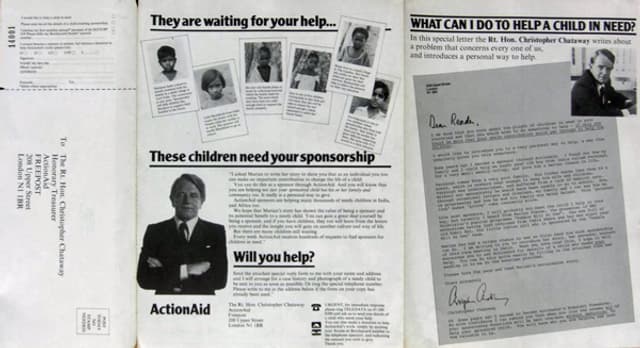ActionAid: the inserts with built-in reply mechanism
- Exhibited by
- Ken Burnett.
- Added
- September 05, 2009
- Medium of Communication
- Inserts, press advertising
- Target Audience
- Individuals
- Type of Charity
- Children, youth and family, international relief/development, poverty/social justice
- Country of Origin
- UK, USA
- Date of first appearance
- September, 1981
SOFII’s view
This is the story of an innovative new development that transformed donor acquisition for what is now one of Britain’s major charities. Sometimes, when an opportunity comes along, you just have to grab it. Or you can choose to overlook it and leave the opportunity to others, if you prefer. By clicking on the video link below you can hear how that opportunity came about and how the failure of many of Britain’s largest charities to recognise and seize the moment left the field open to little ActionAid, allowing it to grow like never before.
Creator / originator
The marketing and communications team at ActionAid – Ken Burnett copywriter, Celia Cole production manager, Ernst Goetschi media placement and Roy Williams freelance designer, plus Webcraft Inc of New Jersey and their persistent British rep Derek Lockyer. The first ActionAid insert was his first order. Most of the other inserts shown were produced by the splendid Smith Bundy agency, headed by the legendary George Smith.
Summary / objectives
To recruit new donors in large volumes and at low cost. A secondary objective was to present and explain the complex story of ActionAid’s distinctive approach to child sponsorship.
Background
ActionAid has for some time been one of the UK’s top 20 charities by voluntary income. But at the time of this story it was a small charity, relatively unknown and barely figuring in the UK’s league table of top fundraisers. ActionAid was founded in 1972 and began promoting child sponsorship in 1975, mainly in the specialist religious press. By 1981 it had graduated to using quite sophisticated couponed newspaper advertisements (usually 20cms x two columns) mainly in the quality daily and Sunday national press. But the range of cost-effective media was few and if ActionAid ads appeared too often their effectiveness fell away. To fulfil the charity’s growth aspirations, something more was needed. The loose insert – the first ever insert in a quality Sunday newspaper – appeared just when it was needed. It also produced the required volume of new donors at a very agreeable cost. There’s no doubt that the development of this insert transformed donor recruitment in the UK, at least for a while. Up till then, loose inserts were considered a peripheral low volume source of recruitment, mainly appearing in small circulation specialist magazines for membership and subscription promotions, or similar. For a complex proposition like child sponsorship, inserts offer the chance to tell their story in detail. The addition of a reply form and pre-paid envelope transformed the loose insert into a prime donor recruitment vehicle for many causes, ranking alongside press ads and direct mail. For a while, at least. As usual, response to these inserts declined, mainly as a consequence of over-use. Familiarity breeds contempt and soon British people began to get fed up with complicated leaflets falling out of their Sunday papers at breakfast time. Perhaps there are some lessons in this? Inserts still have a place in the fundraiser’s repertoire, though not perhaps as glorious a place as in their heyday.
Special characteristics
The insert was a simple four-page black and white leaflet with the, at the time, unique feature of a built-in reply form and envelope attached to the fore-edge of page three, folded, gummed, perforated, ready to be completed and popped in the post.
Influence / impact
Massive: a new format was created, copied by dozens, perhaps hundreds of other organisations. The insert won many UK and European marketing awards and other accolades. And ActionAid’s growth took a huge leap forward.
Details
Response to all ActionAid press advertisements was rigorously recorded, at that time in a guard book that detailed response to each campaign and each insertion. Ads were split (A/B) tested to see the influence of a change in copy or coupon layout, etc. The arrival of the loose insert meant that creative tests and even format tests could be carried out much more easily. It was not unusual for 1- 2 million piece insertion booked in the Observer magazine or the Sunday Times to feature a dozen or more different tests. All results were rigorously recorded, monitored and analysed by Ernst Goetschi.
Costs
No records of costs have been found, so far.
Results
No records of detailed results have been found, so far. But these inserts worked spectacularly initially, producing confirmed new sponsors at a fraction of the cost of traditional recruitment methods. Over time, the response from inserts declined steadily and their use was dropped in the 1990s.
Merits
This is by any standards a major communications initiative which led to the development of a revolutionary new fundraising format.
The story behind this exhibit is explained here.
Please see the accompanying video clip. Lots of people have observed that this story catalogues a very lucky series of events for ActionAid, though I’ve always found that if you surround yourself with the right people, then the harder you work, the luckier you get.
 View original image
View original image
 View original image
View original image




















